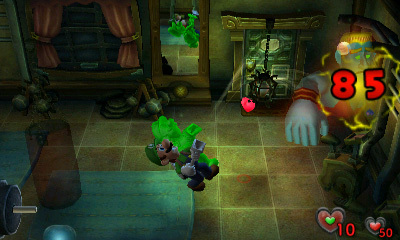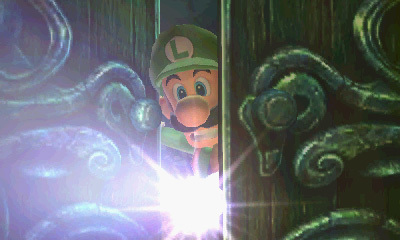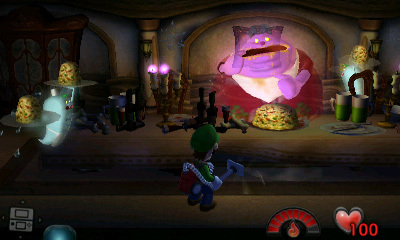Luigi's Mansion was a curious launch title for the GameCube back in 2001, and it's even more curious as an end-of-life title for the 3DS. It's got the feel of an eccentric mid-generation release, a July stopgap to keep you going while you wait for the next major title. But Nintendo's faith in Luigi's Mansion, which has taken on a cult status over the years and has a second sequel due to release on Switch next year, isn't misplaced--the game still has a lot of charm.
Luigi's Mansion sees Mario's put-upon younger brother exploring a mansion after receiving a letter telling him that he won it in a contest. He arrives to find that not only is the mansion haunted and full of ghosts, but that Mario received a similar letter and has not been seen since he entered.
When it released, the game represented a major shift away from the usual Mario format--there's no jump button here. Instead, Luigi has a flashlight and a ghost-sucking vacuum (the Poltergust 3000), which he needs to use to rid the mansion of ghosts and save a captured Mario in the process. You move through the mansion methodically, unlocking new rooms by vacuuming up the ghosts in the ones you've already opened.
The ghosts are divided between your standard ghoulies, 'portrait' ghosts (mini-bosses and bosses, essentially, which have escaped out of paintings), and Nintendo's familiar Boos. Standard ghosts come in a few different varieties--some will grab you, others will punch, throw bombs, or hurl banana peels for you to slip on--and can be vacuumed up once you shine your flashlight at the heart visible in their ethereal chests. When you start up your vacuum, Luigi will be dragged around the room as they try to escape, and you lower their hit-points by pulling the stick away from them, as though Luigi was pulling back, while keeping the vacuum trained on them. It's a fun system, especially when you manage to nab multiple ghosts at once and have to put in the effort to reel them all in.

Luigi's 'Strobulb' flashlight from Luigi's Mansion 2 has also been added. The Strobulb, which can be charged for an extra big flash of light, is useful in a few scenarios--I found that it was helpful for nabbing multiple invisible enemies at once--but the game was designed with a standard flashlight in mind, and I mostly stuck with it.
Portrait ghosts are the main meat of the game and capturing them generally involves solving a small puzzle or figuring out the pattern of their movements. None of them are too complicated--you can examine each portrait ghost for a clue, and simply interacting with the objects in the room will usually trigger the ghost's 'stun' state so that you can begin to vacuum them. These are fun encounters, even if their patterns are usually easy to predict. Hunting the 50 Boos that scatter around the mansion at a certain point in the story is enjoyable for the first 40-or-so--a blinking light on the screen lets you know when you're close to one, and during a chase they can slip through walls and into other rooms--but the novelty of these pursuits wears out towards the end of the game.

Once most of the mansion's doors are open and its rooms cleared are towards the end you'll have to do a lot of backtracking, which can get tedious. But it's worth tracking down every ghost--this is a short game, and you'll get more out of it if you hunt down everything. The brevity of Luigi's Mansion was a major complaint during the initial launch, and while our expectations regarding game length have shifted somewhat (six-hour games are less unusual than they were at the time) Luigi's Mansion still feels like it ends too early. While you can replay for a high score, dictated by how much treasure you find and earn, or play the more difficult 'Hidden Mansion' mode that unlocks after finishing the game, the core experience is still a tad thin. 2013's Luigi's Mansion: Dark Moon was a big improvement in this regard, although there's still an allure to the original game's focus on a single location that you slowly master.
The 3DS' second screen is put to great use too, now displaying a 2D map of the mansion at all times. This makes navigation much easier than it was on the GameCube, as there's no need to bring up a separate map screen, which cuts down on some late-game frustration. You now tilt the 3DS to dictate where Luigi is pointing his light or vacuum, which mostly works but can be finicky when the camera plays up in some of the game's tighter spaces. Although the game supports the C-stick on the New Nintendo 3DS, it's not viable since Luigi barely moves his torch or vacuum when using it--motion controls are essential.

Despite these few tweaks and additions, Luigi's Mansion still feels like the same game it was in 2001. That means the little touches that made the game so memorable have remained. Luigi still charmingly hums the theme tune--confidently or fearfully, depending on whether the room you're in has been cleared or not--and his shaky animations are as much of a delight as ever. Luigi still carries a translucent purple 'Game Boy Horror', which can be used to scan rooms for clues. Even the hilarious interact animation that makes it look like Luigi is humping everything in the room, often paired with an enthusiastic 'oh, yeah!', is unchanged. The stranger puzzles and curious aesthetic elements that you might remember remain, and it serves as an interesting, fun look into how Nintendo managed the transition into their fourth console generation.
Luigi's Mansion is the only GameCube port Nintendo has put onto the 3DS, and while some details have been noticeably toned down for the 3DS' smaller screens (the ghosts are less translucent, for example) there's nothing that feels like an unreasonable compromise. The game adapts to a lower resolution much better than many of the Wii and Wii U ports we've seen to the 3DS, giving the game the curious feel of an excellent tech demo for a system that is now on its way out.
The main new feature is an offline co-op mode, which lets you play the entire game through with another player if they also have a copy of the game (or replay boss fights with anyone who owns a 3DS). The second player gets to control a version of Luigi made entirely from green goo, and can assist throughout the game by sucking up ghosts and helping to solve puzzles. This is likely to be a very niche feature--Luigi's Mansion is not an especially difficult game and playing together on your 3DS just doesn't appeal the same way a traditional console does--but it's a neat bonus. The whole game also supports 3D, and looks great with the slider turned up.

The game also supports four amiibo--Mario, Luigi, Toad, and Boo--and each one will make your game permanently easier. Mario will change the poisonous mushrooms ghosts sometimes spit out into super mushrooms that restore health, Luigi gives you a chance of surviving death, and Boo will mark the location of five undiscovered Boos on the map. By far the most useful, though, is Toad--the Toads scattered around the mansion act as save points, and if you scan this amiibo they'll also restore your health. This is the one enhancement that should have been made universal--not having to shake every item in every room for hearts takes some potential tedium out of the game.
Seventeen years after its first release, with one sequel out and another on its way, there's still nothing quite like Luigi's Mansion. Nintendo's strange foray into the paranormal has aged well--I was surprised at how much of it had stuck in my memory, and how good it felt being back in its haunted halls. It's a basic port with a few issues, but Luigi's Mansion still remains a charming and enjoyable game.



















